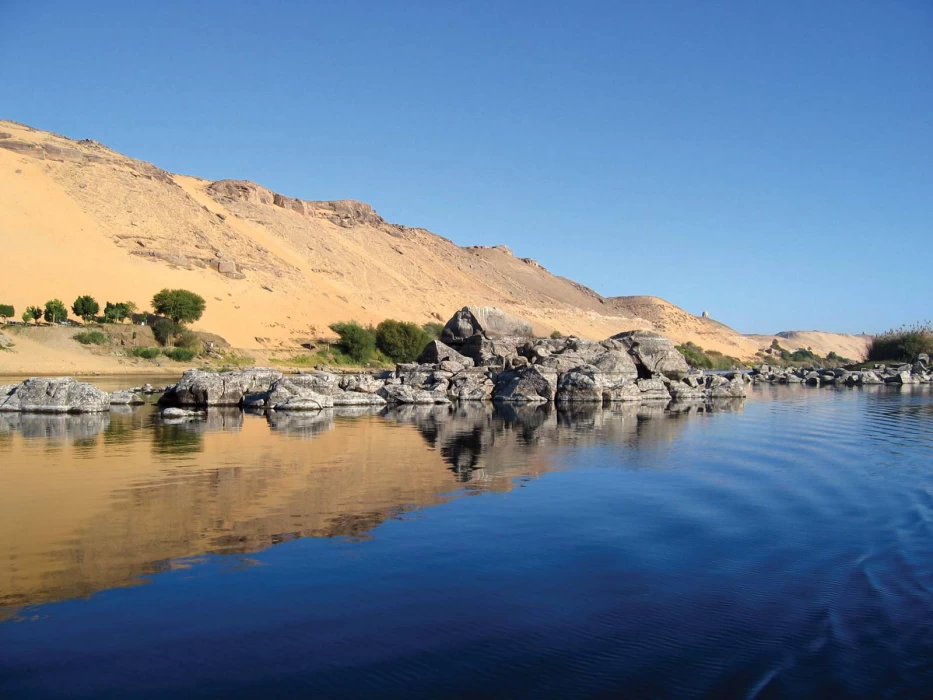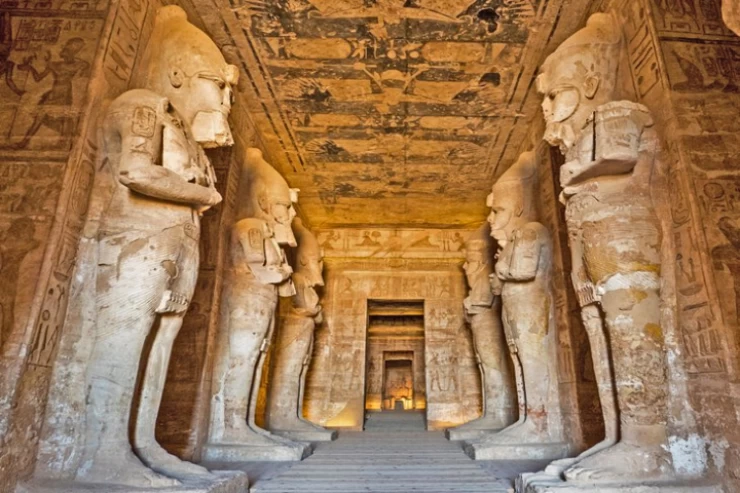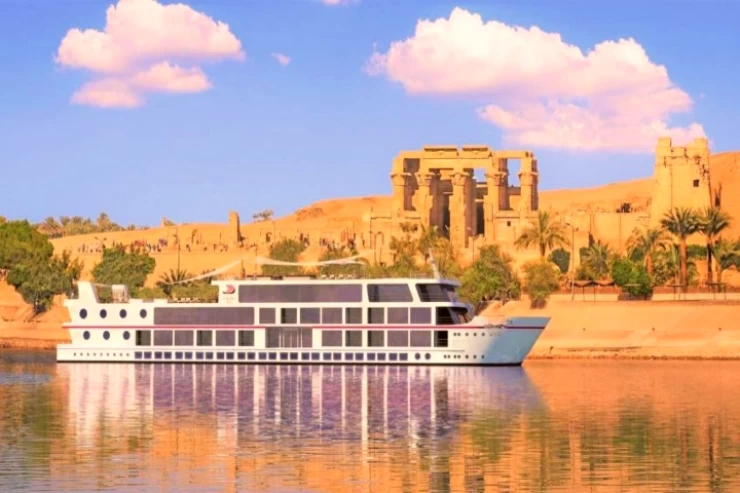
Il fiume Nilo
Il fiume Nilo
Il fiume più lungo del mondo è Il fiume Nilo più lungo del mondo, poiché si estende a sud dell'equatore e scorre a nord-est. Coprendo 3349000 km2, il bacino comprende 11 paesi africani: "Uganda, Eritrea, Ruanda, Repubblica Democratica del Congo, Tanzania, Burundi, Kenya, Etiopia, Sud Sudan, Sudan ed Egitto".
Il fiume Nilo è considerato la ragione principale dello sviluppo della civiltà egizia migliaia di anni fa, secondo gli scritti dell'antico storico greco Erodoto che affermò che l'Egitto è il dono del Nilo, dove le terre aride del deserto egiziano si trasformarono in fertili terre dovute alla formazione di depositi di limo lungo le rive del fiume Nilo, che portarono alla crescita dell'antica civiltà egizia, questa era coltivata a grano, lino e papiro lungo le rive del Nilo
Il Nilo in Egitto si estende dal confine settentrionale del Lago Nasser ad Assuan a nord del Cairo, dove il Nilo è diviso per formare il delta del Nilo in due rami, Rashid e Damietta.
In tempi antichi, i primitivi egizi si stabilirono lungo le rive del fiume Nilo dove costruirono semplici case e cottage per l'alloggio, coltivarono molti raccolti e da allora furono iniziati i primi passi verso la gloria egiziana. La coltivazione era il punto di partenza quando il fiume Nilo irrigava, trasportando depositi di limo che coprivano le terre lungo la valle del Nilo e le rendevano fertili. Il grano era il primo prodotto coltivato dagli antichi egizi, dipendente dalle inondazioni del Nilo come soluzione alla minaccia della fame e della mancanza di cibo in quel momento. Dall'altro lato, usavano alcuni animali come bufali d'acqua e cammelli per il cibo, l'aratura e il trasporto di merci.
Oltre il 95% della popolazione della Repubblica egiziana vive sulle rive del Nilo, e in questo modo la Valle del Nilo è una delle aree più densamente popolate al mondo, con una popolazione media di circa 3.820 persone per 1,61 quadrato chilometri, e la ragione di ciò è che il Nilo è la linfa vitale della Repubblica egiziana, dove gli agricoltori producono grandi quantità di colture diverse come agrumi, cotone, grano, canna da zucchero, legumi e sorgo. Nonostante il successo dei programmi agricoli nel bacino del Nilo, i flussi del Nilo sono ancora scarsi in alcuni paesi, quindi l'iniziativa del bacino del Nilo è iniziata nel 1999. Al fine di aiutare questi paesi a beneficiare del fiume
Come parte degli interessi della vita religiosa degli antichi faraoni e della loro insistenza nel creare molti dei e dee per gli elementi fisici, hanno onorato il fiume Nilo creando Sobek "Dio del Nilo" o è stato chiamato "Dio del coccodrillo" il dio di un uomo con una testa di coccodrillo rappresentava la fertilità, le zone umide, la medicina e la morte improvvisa e il fiume Nilo è considerato il sudore di Sobek. Un altro dio correlato al Nilo nell'antico Egitto è "Hapi" è chiamato "Signore del fiume che porta vegetazione" o "Signore dei pesci e degli uccelli delle paludi", il dio delle inondazioni annuali del Nilo che controllava notevolmente il livello dell'acqua.
Puoi viaggiare in Egitto e navigare attraverso il fiume Nilo a bordo della crociera sul fiume Nilo in Egitto e sulla crociera sul lago Nasser, Cairo Top Tours offre le migliori offerte e offerte per Egypt Classic Tours, Cairo private tours, Egypt Travel Packages, Egypt day tours, Cairo day tour e tour giornalieri del Cairo dall'aeroporto per soddisfare i desideri dei viaggiatori sui luoghi storici e sui vari musei in Egitto, i rappresentanti di Cairo Top Tours ti aiuteranno durante i tuoi pacchetti Classic in Egitto e copriranno la maggior parte della terra dei Faraoni, Prenota ora per una grande esperienza di vacanze in Egitto e pacchetti vacanza in Egitto e tour in Egitto e vivi l'esperienza di prenotare gite in feluca al Cairo e visitare l'Egitto.
Il nostro team vi aiuterà a viaggiare in Egitto e sperimentare il tempo soleggiato del nostro bel paese durante la Pasqua, grazie alla loro vasta conoscenza del turismo egiziano. Puoi personalizzare il tuo pacchetto selezionando uno dei nostri pacchetti di viaggio in Egitto o sfruttare al massimo il tuo tempo in una breve visita, imparando di più sulla storia egiziana e le sue affascinanti storie e vivendola attraverso tour privati al Cairo. Partecipa a uno dei nostri tour economici in Egitto attraverso il deserto del Sahara, come i tour di Siwa dal Cairo, per esempio, o preferibilmente i tour nel Deserto Bianco d'Egitto. Scoprite i nostri tour di un giorno ad Assuan, fate una gita di un giorno da Assuan ad Abu Simbel, o viaggiate via terra e godetevi i nostri tour di un giorno a Luxor per vedere gli incredibili templi di Karnak, il Tempio di Luxor, il Tempio di Hatshepsut, e vedete le meravigliose tombe splendidamente dipinte nella Valle dei Re, questo è il luogo dove i re e i governanti del nuovo regno riposano in pace e imparate i loro riti di mummificazione e sepoltura. Noi di Cairo Top Tours non risparmiamo sforzi per offrirvi il meglio dei nostri tour e delle nostre escursioni in Egitto.
Disregarding its claim to being the longest river in the world, the Nile epitomizes all that is Egypt in terms of geography, history, and culture. The Nile is located in the northeastern region of Africa and is about 6,650 kilometers long (4,130 miles), running through 11 different countries before emptying into the Mediterranean Sea. Nevertheless, the most well-known portion of the river is certainly in the country of Egypt, where not only has the river formed the present-day geography of the place but also sustained one of the most ancient and greatest civilizations in the world. It is often referred to as the ‘Gift of the Nile’. Most of the wealth, progress, and history of Egypt have revolved around this river.
Egypt boasts of long stretches of deserts, but it is interesting to note that the Nile River has succeeded in forming a vegetative zone in the region otherwise characterized by dry lands. Without the Nile River, the majority of regions within this nation’s borders would more likely than not be empty and unproductive land. It supplies water, which is sourced for farming, business, and even household use. In ancient times, the Nile used to spill over its banks, and every year the lands along the river, such as the region around the Nile, received rich alluvial deposits that were excellent for farming. These floodwaters every year without fail were perfect for growing crops for the ancient Egyptians, who grew different crops such as wheat, barley, and flax, which were the main food and agricultural income of this community.
Today, while the Aswan Dam was built in 1970, which led to the complete control of tree flooding and therefore the abolition of the age-old flood regime, the Nile River is still of great importance for agriculture in Egypt. Filmy green container siding strips that fit perfectly along the banks of the river, which is reminiscent of the shape of the river, sharply contrast with the yellow sand canvas of the desert, indicating that the Nile River is of key importance to the people of Egypt.
The Nile was an important resource for agriculture, but its relevance does not end there; much of today’s world owes its existence to Egypt as we know it. Civilizations flourished on both banks of the ancient Nile as it provided not just water and rich alluvial plains, but also integrated the two banks using transport and communication. The river was crisscrossed by boats transporting goods, people, and ideas, effectively bridging the gap between Upper and Lower Egypt and emerging as one of the most powerful kingdoms.
Furthermore, the river found its place also in the divine and cultural aspects of the ancient Egyptians. The floods of the river, which were very important for agriculture, were treated in ancient times as a curse from Hapi, the protective god of the fertile Delta and the Nile. The river was also linked with the idea of death and what came after it. The Egyptians believed that the east side of the Nile River where the sun rose was the region of the living, while the west side where sunset occurred was the realm of the dead. This explains why some of the country’s most popular structures, including the Great Pyramids and the tombs in the Valley of Kings, are located on the western bank of the river.
The legacy of the Nile is inscribed in the very topography of the nation of Egypt, with nearly all its iconic representations located along the banks of the river. In Cairo, for instance, west of the Nile runs the Giza Plateau, which houses the Great Pyramid among other pyramids, and the infamous Sphinx that has stood for more than 4500 years. The stones used to create these buildings rose from within the depths of the Nile and were transported therein, thus revealing the contribution of the river towards the architectural peculiarity of Egypt.
Going further down south to Luxor, yet another ancient hub, the Nile cuts across it. East Bank consists of the vast temples of Karnak and Luxor, which were the places of worship for the exalted pharaohs. West Bank is characterized by the flat surface of the Valley of the Kings, which hosts the burial places of the most powerful kings’ in Egyptian history, with the famous King Tut’s tomb being one of them. It was the Nile that linked those cities and the temples, and the Nile waters flowed in bringing the resources necessary for erecting such remarkable edifices.
One of the striking cases of the power of the Nile on Egyptian monuments might be the temples of Abu Simbel, which are found on the southern border of Egypt close to Sudan. Colossal temples were carved by the mountain by Ramses II, and since they are located close to the river, there was a risk when the Aswan High Dam was being built. In an astonishing engineering accomplishment, the temples were moved to a higher location to protect them from the adverse effects of the water levels of Lake Nasser, an enormous reservoir that was built because of the dam. At this point, they are both an ancient and contemporary reminder of the connection that Egypt has with the Nile.
The Nile is still an integral aspect of modern-day Egypt. The river is still used for irrigation and even provides drinking and industrial water. It has also maintained its relevance as a waterway, and especially as a tourism-based route. Cruises on the Nile between Luxor and Aswan allow tourists to experience the beauty of the river and, along the way, some of the exotic historic sites of Egypt. This pace of the river sets the mood for temple, tomb, and village raids, which are fun-beholding sights of historical Egypt.
The Nile has been a major factor in the growth of cities like Cairo, Aswan, and Luxor. In Cairo, the Nile passes through the very middle of the populated city, providing a serene gate away from the noisy road. Corniche El Nile, which is a wall fronting the river in the city, is frequented by people, both locals and tourists, who go there to see the river, and particularly sunsets are breathtaking. Calm sailing wooden boats called feluccas move on top of the river, recalling the magic of the serene Nile.
Aswan is characterized by the majestic flow of the Nile that meanders, surrounded by patches of granite and tiny islands, providing an ideal ambiance to learn about the Nubian culture and Philae Temple. The slower-paced atmosphere created by the clear waters in Aswan makes it one of the most captivating places along the Nile, where visitors feel relaxed as if everything is flowing with the river at a gentle pace.


















